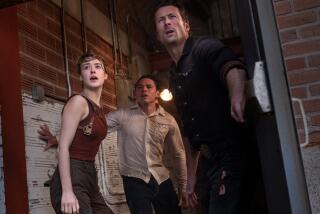Writer-director Christopher Nolan’s “Tenet” is spun from the thread of criminal espionage where John David Washington plays a charismatic super-spy on a mission to save the world. But instead of high-tech cars or disguises to outwit his antagonist (menacingly played by Kenneth Branagh), his cape is “time inversion,” which allows him to move backward in time while the rest of the world around him keeps moving forward.
“It’s Chris Nolan on steroids, almost,” says visual effects supervisor Andrew Jackson, who’s been nominated for an Oscar and Visual Effects Society Award for the film. “It’s an extreme version of playing with the idea of time,” he says of writer-director Christopher Nolan’s September release.
Reading the script, Jackson recognized that it was going to take effort to determine the look. It wasn’t in the cards to simply present forward action and reverse it, or have effects that feel like fantasy. For “Tenet,” visuals had to tout an unusualness that was grounded in the real world.
The philosophy for the VFX was rooted in in-camera shooting — to harness compositing or CG only when necessary. Jackson, who started out in practical effects before moving into visual effects, was comfortable sitting between the two worlds, and with Nolan having involved key departments early on, including special effects supervisor Scott Fisher, they could discuss ideas at length.
Early conversations leaned into how objects or people would move backward in time. On screen, an inverted person moves backward, but from their perspective, they are traveling forward, and the world around them is moving in reverse. “The discussions were like exercising a muscle you never used before. We needed to be able to visualize the forward and backward events together while at the same time thinking about the point of view on an inverted observer,” Jackson notes.
The impetus for approaching more ambitious scenes came from the 3-D previs that Jackson designed on a laptop. One sequence was a pulse-pounding car chase (shot in Tallinn, the capital city of Estonia) that had action moving forward and backward in a ticking will-they-get-away thrill ride. The previs, or digital preview of the action, became an integral resource for Nolan and team as a way to check if the story points were chronologically correct.
“It was a difficult scene to figure out, because the audience not only sees it once normally but also later on in the film in reverse. With the previs, we could scrub through the sequence to make sure it all made sense logically from any point in time and from anyone’s perspective,” he explains.
Another weighty scene involved crashing a real 747 airplane. “That was a huge one,” Jackson says. “Our initial thought was to create it with miniatures and CG, but because we had to a do a scene leading up to the crash earlier, it worked out so that we could build the set and generate the full-sized crash.”
To pull off the sequence, it was shot at an airport in Victorville, Calif., using a decommissioned plane that was restored for the film. Production built the set piece that the plane would crash into, and then visual effects enhanced the explosion and cleaned up other areas to the single-take shot. “We added some CG trees that were sucked into the engine reacting to the blast and tidied up the fence line and removed all the tow ropes, but the meat of the shot was in camera,” Jackson says.
It wasn’t only the crew that needed to think palindromic. Actors and stunt teams learned their actions both forward and backward as well. The key to any scene, especially fighting sequences, was figuring out what was the most difficult thing to do backward. Whatever that was, it would be filmed forward and the footage reversed in post.
For instance, if someone was falling down, that action couldn’t be performed in reverse, so it would be filmed in forward motion. Then the actor playing opposite the actor falling would perform his own actions backward to create the scene. This allowed postproduction to keep the action as it plays out, or reverse it, depending on where it landed in the story.
This was evident during the climactic battle sequence. Among the chaos is one of Jackson’s favorite moments, where the VFX team got to explode and implode a building at the same time. To piece it together, two exact buildings were constructed and blown up from matching camera angles so they could reverse the action of one of them and composite the two elements together to achieve the effect.
“It’s a good example of one of the uses where we had to add CG components to the top of the building falling, because the dust from the plate explosion was so strong you couldn’t see the building anymore. It was a big job but still based on visual effects and how we have to tidy things up.”
Even for such an imposing concept, the visual effects team needed to turn over only about 300 shots, far less than any current superhero film. “That number is not unusual for Chris,” Jackson says. “Figuring out ways to shoot real effects is ideal. If we don’t have to do any work in post, it will be that much more pleasant for him.”
More to Read
From the Oscars to the Emmys.
Get the Envelope newsletter for exclusive awards season coverage, behind-the-scenes stories from the Envelope podcast and columnist Glenn Whipp’s must-read analysis.
You may occasionally receive promotional content from the Los Angeles Times.







